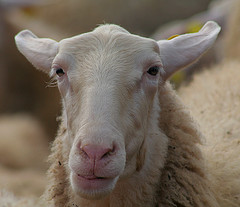
A group of Chinese cardiologists at Capital Medical University have done a quick ewe-turn, pulling a paper after mixing up both the author order and wrongly reporting how many sheep were killed in the making of this experiment.
We covered another retraction from the CMU cardiology department in September. The sheep paper was published in October.
Here’s the notice for “Mosaic tissue-engineered porcine pulmonary artery valved conduit: long-term follow-up after implantation in an ovine model”:
The online version of this paper published on the advance access platform of Interactive CardioVascular and Thoracic Surgery (ICVTS) has been retracted at the request of the corresponding author Dr Wenbin Li and in agreement with all authors on the grounds that the order of the authors does not meet the requirements of the funding body, the National Natural Science Foundation of China. Furthermore and more importantly, Dr Wenbin Li has claimed that the version published in ICVTS contains erroneous data. Of the 12 sheep of the experimental group, only 6 sheep, not 11 as given, survived to 1 year and the remaining sheep were sacrificed at 6 months for mid-term experiments.
The authors apologise to the readers of Interactive CardioVascular and Thoracic Surgery.
We got in touch with managing editor Judy Gaillard for more details, but she just repeated what was in the notice:
As mentioned in the retraction notice it is the corresponding author of the ICVTS paper who contacted us to request that the paper be withdrawn because a) there was a problem with the order of the authors and b) the authors discovered, after publication of the ICVTS article, that the data reported are incorrect.
It’s not clear how the error occurred; we’ve reached out to Li for more information. We’ve also contacted CMU to find out if they’re making a particular effort to clean up the cardiology department’s literature, and will update if we find anything out.
Bonus: When another research group ended up with the wrong sheep, their solution involved methamphetamines and Tasers.
Hat tip: Rolf Degen
Authors must be felling… …well sheepish.
Sorry, irresistible 🙂 we need more mix-ups in papers on sheep
I’m glad the authors came clean about this, rather than trying to pull the wool over everyone’s eyes.
There is nothing like a wolf in sheep’s clothing. The olden day parable for the anonymous movement.
It could be worse, although as far as I know, there was no plagiarism.
At Jounral of Scientific Exploration we find Unexplained Weight Gain Transients at the Moment of Death
“Abstract—Twelve animals (one ram, seven ewes, three lambs and one goat) were studied. At the moment of death an unexplained weight gain transient of 18 to 780 grams for 1 to 6 seconds was observed with seven adult sheep but not with the lambs or goat. The transients occurred in a quiet time at the moment of death when all breathing and movement had ceased. These transient gains are anomalous in that there is no compensating weight loss as required by Newton’s Third Law. There was no permanent weight change at death. Dynamic weight measurements may present a fruitful area of investigation.”
Is this another Bohannon-style sting paper? It’s time to separate the sheep from the goats. And, in science, retractions are starting to precisely that. And the rhyme ends with… “have you any more? Yes sir, yes sir, three and four”. Very apt for RW.
Sting? Not in the slightest, Go scan the list of past articles at JSE until you have it calibrated. They are quite serious.
Or, you can try The JSE is a dog., where I review one of the issues of JSE.
John, thanks for this link. I did find one really bizarre paper that could be of interest to RW readers:
How to Reject Any Scientific Manuscript by D. Gernert:
http://www.scientificexploration.org/journal/jse_22_2_gernert.pdf
The journal content is bizarre, but the society sounds really powerful:
http://www.scientificexploration.org/about_sse.html#contact
It states:
“The primary goal of the international Society for Scientific Exploration (SSE) is to provide a professional forum for presentations, criticism, and debate concerning topics which are for various reasons ignored or studied inadequately within mainstream science. A secondary goal is to promote improved understanding of those factors that unnecessarily limit the scope of scientific inquiry, such as sociological constraints, restrictive world views, hidden theoretical assumptions, and the temptation to convert prevailing theory into prevailing dogma.
Topics under investigation cover a wide spectrum. At one end are apparent anomalies in well established disciplines. At the other, we find paradoxical phenomena that belong to no established discipline and therefore may offer the greatest potential for scientific advance and the expansion of human knowledge.
The Society encourages such investigations for several reasons that may appeal to different communities:
•To the research scientist, we commend the intellectual challenge of explaining away an apparent anomaly or seizing the new knowledge presented by a real one.
•To the student scientist, we point out that science does not begin with textbooks: it begins with the unknown and ends with textbooks.
•To the nonscientist, we acknowledge that deep public interest in some of these topics calls for unprejudiced evaluation based on objective research.
•To the policy-maker, we point out that today’s anomaly may become tomorrow’s technology.”
Well, well, this could be an interesting open access depository for post-publication peer review case studies…
Can any RW reader please provide the exact “requirements of the funding body, the National Natural Science Foundation of China”. Specifically, we need to understand, publically, how grants in Chinese research institutes are allocated to researchers, and using what system of rewards.
How does the position or status of the author count? So does a first author, corresponding author and last senior author obtain different levels of funding for publishing a paper?
Are Chinese universities ranked? If yes, what are the criteria required to achieve that ranked status?
How are impact factors factored into raises in salaries, grants and positions?